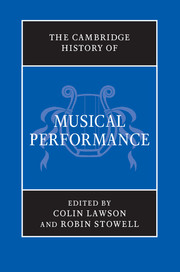Book contents
- Frontmatter
- PART I PERFORMANCE THROUGH HISTORY
- PART II PRE-RENAISSANCE PERFORMANCE
- PART III PERFORMANCE IN THE RENAISSANCE (C. 1430–1600)
- 12 Performance in the Renaissance: an overview
- 13 Vocal performance in the Renaissance
- 14 Instrumental performance in the Renaissance
- 15 Case study: Seville Cathedral's music in performance, 1549–1599
- PART IV PERFORMANCE IN THE SEVENTEENTH CENTURY
- PART V PERFORMANCE IN THE ‘LONG EIGHTEENTH CENTURY’
- PART VI PERFORMANCE IN THE NINETEENTH CENTURY
- PART VII THE TWENTIETH CENTURY AND BEYOND
- PART VIII
- Index
15 - Case study: Seville Cathedral's music in performance, 1549–1599
from PART III - PERFORMANCE IN THE RENAISSANCE (C. 1430–1600)
Published online by Cambridge University Press: 28 March 2012
- Frontmatter
- PART I PERFORMANCE THROUGH HISTORY
- PART II PRE-RENAISSANCE PERFORMANCE
- PART III PERFORMANCE IN THE RENAISSANCE (C. 1430–1600)
- 12 Performance in the Renaissance: an overview
- 13 Vocal performance in the Renaissance
- 14 Instrumental performance in the Renaissance
- 15 Case study: Seville Cathedral's music in performance, 1549–1599
- PART IV PERFORMANCE IN THE SEVENTEENTH CENTURY
- PART V PERFORMANCE IN THE ‘LONG EIGHTEENTH CENTURY’
- PART VI PERFORMANCE IN THE NINETEENTH CENTURY
- PART VII THE TWENTIETH CENTURY AND BEYOND
- PART VIII
- Index
Summary
In 1549 the young Francisco Guerrero returned to his native Seville as a contralto singer of the cathedral. He remained there until his death in 1599, serving as assistant chapelmaster and (from 1574) chapelmaster. Seville Cathedral, the largest Gothic church in the world, dominated the musical life of a city and region enjoying a golden age both economically and culturally, given its central role in trade with the New World. Indeed, the cathedral's liturgical and musical practices influenced those of many New World churches. This chapter considers musical performance within two liturgical contexts at the cathedral: the Marian Salve service and Vespers of a high-ranking feast. It examines how various types of polyphony and instrumental music were deployed in these contexts, taking elements of Guerrero's output as specific examples. This selection allows the reader to draw some comparisons with the repertoire discussed in Chapter 19 of this book, namely Monteverdi's Marian Vespers music published in 1610. More generally, the influence of Seville Cathedral and the broad dissemination of Guerrero's music nationally and internationally lends wider relevance to some of the performance issues raised here, as does the degree of common musical practice among Iberian churches.
The provision for vocal and instrumental music at Seville Cathedral was of a lavishness designed to reflect the magnificence of the cathedral, in competition with Toledo, the primatial church of Spain. In 1587, Alonso Morgado commented that ‘the music and the choir, both of voices and of instrumentalists, shawms, trombones, bassoon, recorders, cornetts, and all instruments, can compete with the finest in Christendom’. This musical establishment encompassed several (and in some cases overlapping) groups of personnel.
- Type
- Chapter
- Information
- The Cambridge History of Musical Performance , pp. 353 - 374Publisher: Cambridge University PressPrint publication year: 2012



